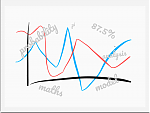5. April 2020
Thoughts on Model Thinking: a smörgåsbord
 A review of Scott Page’s Model Thinking course, which has been overall entertaining, inspiring, informative albeit at times a bit repetitive when going through arithmetics. If you are interested in trying to make sense out of the complex world around you, this course might be for you.
A review of Scott Page’s Model Thinking course, which has been overall entertaining, inspiring, informative albeit at times a bit repetitive when going through arithmetics. If you are interested in trying to make sense out of the complex world around you, this course might be for you.
Model Thinking, by Scott Page of the University of Michigan, has been my online course #29 since 2015. Looking back, I am realizing now how many of these courses were either focused on or building on models: models used in machine learning, models used in economics, banking, finance. But I have not taken a course like Model Thinking since I left university.
What is this course about? Model Thinking covers many models, but not necessarily in depth; or otherwise it would not have fit into a twelve weeks course: segregation models, contagion models (on topic these days), percolation models, economic growth models, preference aggregation, spatial choice models, urn models, network models, random walk models, skill & luck models, and several models from game theory to mention a few. It is a smörgåsbord of models.
None of the lectures go into a lot of depth. But Scott Page stresses the point that it is important to have a variety of models to choose from, and to understand the assumptions that each of the models make; and possibly to choose multiple models for a given application. In that sense, the course delivers.
In several of the lessons, I felt that too much time was spent on demonstrating on how to use the model to calculate numeric results. While the first example is illustrative and I am myself a big fan of testing understanding by going through some sample calculation, the second and third time is much less interesting and I wished the time was spent on exploring other material.
There are no assignments, which I can understand given that the people participating in the course are probably coming from different fields, and it would be thus harder to come up with assignments that are a challenge for everyone. Yet, I find that modelling is something that must be practiced; hence taking the course alone without finding some real problems to solve would be entertaining but much less fruitful.
For me, I find plenty of opportunity to apply models, either at work or also for fun: examples on this blog are Modeling Swiss basic health insurance (on how to decide which insurance policy to purchase), Forecasting Ozone levels in London (predicting air pollution using exponential smoothing state space model), Statistics tell you when to stop practicing (modelling the probability of passing an exam, to save cost and effort), What probability theory tells you about starting on time (explaining why waiting for the last person to show up can be a bad idea), Motion Segmentation of RGB-D Videos via Trajectory Clustering (computer vision model to find moving objects in videos from a depth camera), Case study: when average speed matters (explaining why maximum speed isn’t the right thing to look at when calculating travel time), Clustering Crash Simulation Data with LLCA (making sense out of simulated crash tests), Computing PageRank for the Swedish Wikipedia (a network model), Recognizing Textured Planar Objects with OpenCV (recognizing objects based on models). Thus, for me the course was a very good fit for my interests.
Last but not least, I should also mention that participating in this online course is free of charge, which is pretty amazing. If you are up to learn a little bit about many models and hear what they can be used for, if you do not care too much about in-depth discussions, practical exercises, then I highly recommend you go and check it out.